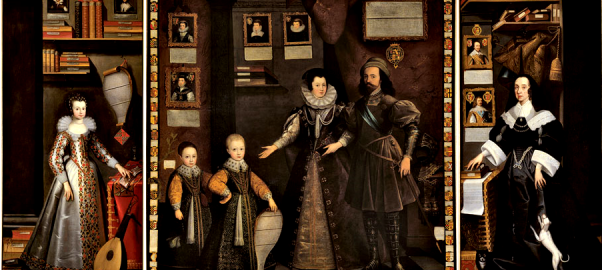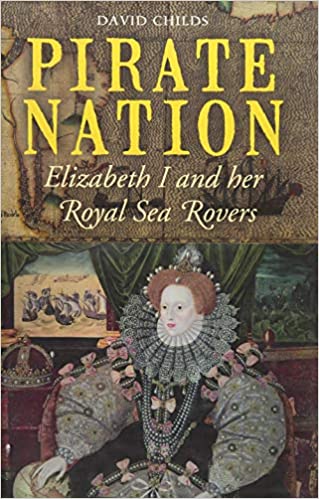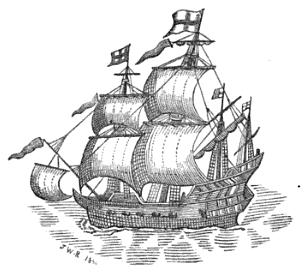I have long held that under the system of counting the years from the imagined year of Jesus’s birth, the year the “17th century” should be considered as starting only on January 1, 1601. But I know that is counter-intuitive to many. So I hereby declare that in this project, we are now entering the 17th century CE.
The event of 1600 CE that over time turned out to have had the biggest impact on world affairs occurred, as it happens, on the very last day of the year, December 31. That was the day on which Queen Elizabeth granted a monopolistic royal charter to a broad group of London merchants to form the “East India Company”, a privately-held joint-stock company that antedated the formation of the “British Empire” by 250 years and for that period exercised in broad swathes of the world rights that today we would consider can legitimately be wielded only by states…
More on the EIC’s founding, below. But first, I just want to present– for my own reference as much as anyone else’s, a list of the dozen political leaders who in the period 1450-1600 exercised the greatest sway in world affairs. I realize that people can disagree about the list. But anyway, here it is below, sorted by the end-year of each person’s reign. A couple of quick notes/thoughts:
- Babur is there because he founded what became a large and well-functioning empire.
- The two Ming Emperors are there not necessarily because they themselves achieved much but because they both held power for such a long time; and because during the reign of at least the deranged Jiajing Emperor, the fact that the empire survived his reign at all seems like a powerful testament to the underlying strength of the whole “Mandarin” system of administration.
- Obviously, in 1600 CE, the last four of these rulers are still on their thrones. But they have all, already, contributed a lot to fashioning the world of 1600 CE.
| Empire | Ruler | Start of reign | End of reign | Years in power |
| Portugal | Afonso V | 1438 | 1481 | 43 |
| Castile | Isabella | 1474 | 1504 | 30 |
| Mughal | Babur I | 1526 | 1530 | 4 |
| England | Henry VIII | 1509 | 1547 | 38 |
| Spain | Charles I/V | 1516 | 1556 | 40 |
| Ottoman | Suleiman I | 1520 | 1566 | 46 |
| Ming China | Jiajing | 1521 | 1567 | 46 |
| Spain | Philip II | 1556 | 1598 | 43 |
| England | Elizabeth I | 1558 | 1603 | 45 |
| Mughal | Akbar | 1556 | 1605 | 49 |
| Ming China | Wanli | 1572 | 1620 | 48 |
| Safavid | Abbas I | 1587 | 1629 | 42 |
The founding of the East India Company
The East India Company was far from the first attempt by a group of merchants and investors in the City of London to found a joint-stock company dedicated to building a trading or colonial-settlement empire in a part of the world not then considered part of Europe. We had earlier seen the Levant Company, the Virginia Company, the Muscovy Company, and so on; and none of those had yet shown any particularly strong return for their investors. But the EIC would– along with a reincarnation of the Virginia Company– be the two that would have the greatest impact on world events over the 420 years that followed.
Actually, what had been most profitable for the investors of London over the decades preceding 1600 had been not the activities of the big, pompous-sounding joint-stock companies but shorter-term investments in repeated and extremely blatant acts of piracy. David Childs, the retired British naval officer who authored Pirate Nation: Elizabeth I and Her Royal Sea Rovers, summarized the situation in England thus (p.2):
By the mid sixteenth century England had earned her epithet of a nation of pirates, but in the quarter century that closed with Elizabeth’s death in 1603, the country had turned from being a nation of pirates into a pirate nation; a state whose own ruler was identified as a pirate queen who (along with most of her advisors, favourites, and legal practicioners) was a beneficiary of piracy
Those had been the sometimes extremely profitable activities of English sea-captains like Martin Frobisher, John Hawkins, Walter Raleigh, Francis Drake, and others whose exploits we have already followed here…
Then, soon after the defeat of the Spanish Armada in 1588, some London merchants started planning to extend their naval-expeditionary activities to the Indian Ocean. A group of these merchants,
presented a petition to Queen Elizabeth I for permission to sail to the Indian Ocean. The aim was to deliver a decisive blow to the Spanish and Portuguese monopoly of Far Eastern Trade. Elizabeth granted her permission and on 10 April 1591 James Lancaster in the Bonaventure with two other ships sailed from Torbay around the Cape of Good Hope to the Arabian Sea on one of the earliest English overseas Indian expeditions. Having sailed around Cape Comorin to the Malay Peninsula, they preyed on Spanish and Portuguese ships there before returning to England in 1594.
Meantime, while that expedition was still at sea, in 1592 all of Southern England rejoiced in the capture of the heavily loaded Portuguese carrack the Madre de Deus, whose riches had also included the ship’s rutter (the detailed log-book of its voyages, navigational conditions, etc.) Then in 1597-8, many of the English merchants and investors must have heard about the success of the first Dutch “joint-stock” expedition to the East Indies…
So in 1599 it was little surprise that many of these merchants came together to try to establish their own joint-stock company as a more stable, continuing entity that could also enter that trade. They raised a total of £68,373 (roughly £15.7 million in today’s currency) in starting capital and started acquiring ships. A first attempt, in 1599, to meet with Elizabeth to gain a royal charter from her did not work out. (Some of the founding investors had been good friends of the now-disgraced Earl of Essex. That may have been problematic?)
The following year– 1600– they tried again. And on December 31, 1600 the Queen granted a Royal Charter to “George [Clifford], Earl of Cumberland, and 215 Knights, Aldermen, and Burgesses”, operating as the “Governor and Company of Merchants of London trading into the East Indies.” The charter awarded the newly formed company a 15-year monopoly on English trade “with all countries east of the Cape of Good Hope and west of the Straits of Magellan”– that is, notably not in the Atlantic Ocean. Any traders in breach of the charter without a licence from the company were liable to forfeiture of their ships and cargo (half of which would go to the Crown and the other half to the company), as well as “imprisonment at the royal pleasure”.
In 1601, Sir James Lancaster commanded the first East India Company voyage aboard the Red Dragon, a 38-gun ship that Clifford had contributed to the company. Clifford, like the Earl of Essex, was another of Elizabeth’s favored younger courtiers. It is possible that at this point he had supplanted Essex in Her Majesty’s affections? Anyway, he was the one who in December 1600 was able to persuade Her Maj to issue the royal charter the new company’s investors felt they needed.
English-WP tells us that Clifford, born in 1558, was renowned mainly as an accomplished jouster who “was described as a man of great personal beauty, strong and active, accomplished in all knightly exercises, splendid in his dress, and of romantic valour… [H]e was a gambler and a spendthrift, a faithless husband, and later, for several years before his death, was separated from his wife.” When young, he had run through most of his generous inheritance, but at the age of 30 he participated in the sea war against Spain, getting a taste for naval adventures and piracy…
(The banner image above is a large-sized triptych depicting Clifford and his family.)
Clifford did not, however, captain the EIC’s first voyage, which set out in 1601. That role was given to James Lancaster VI, who had already led the somewhat successful 1591-94 expedition to the Malay Peninsula. Lancaster captained the Red Dragon and together with two other ships set out to sail around the Cape to the Malay Peninsula. They would achieve this:
After capturing a rich 1,200 ton Portuguese carrack in the Malacca Straits the trade from the booty enabled the voyagers to set up two “factories”[that is, warehouses] – one at Bantam on Java and another in the Moluccas (Spice Islands) before leaving. They returned to England in 1603 to learn of Elizabeth’s death but Lancaster was Knighted by the new King James I. By this time, the war with Spain had ended but the company had successfully and profitably breached the Spanish and Portuguese duopoly, with new horizons opened for the English.
You can learn more about the early voyages of the EIC here. All we really need to know here is that after the first 15 years the charter was renewed and was eventually granted to the EIC in perpetuity. Anyway, the EIC will be a big actor in the P-500-Years postings going forward…



